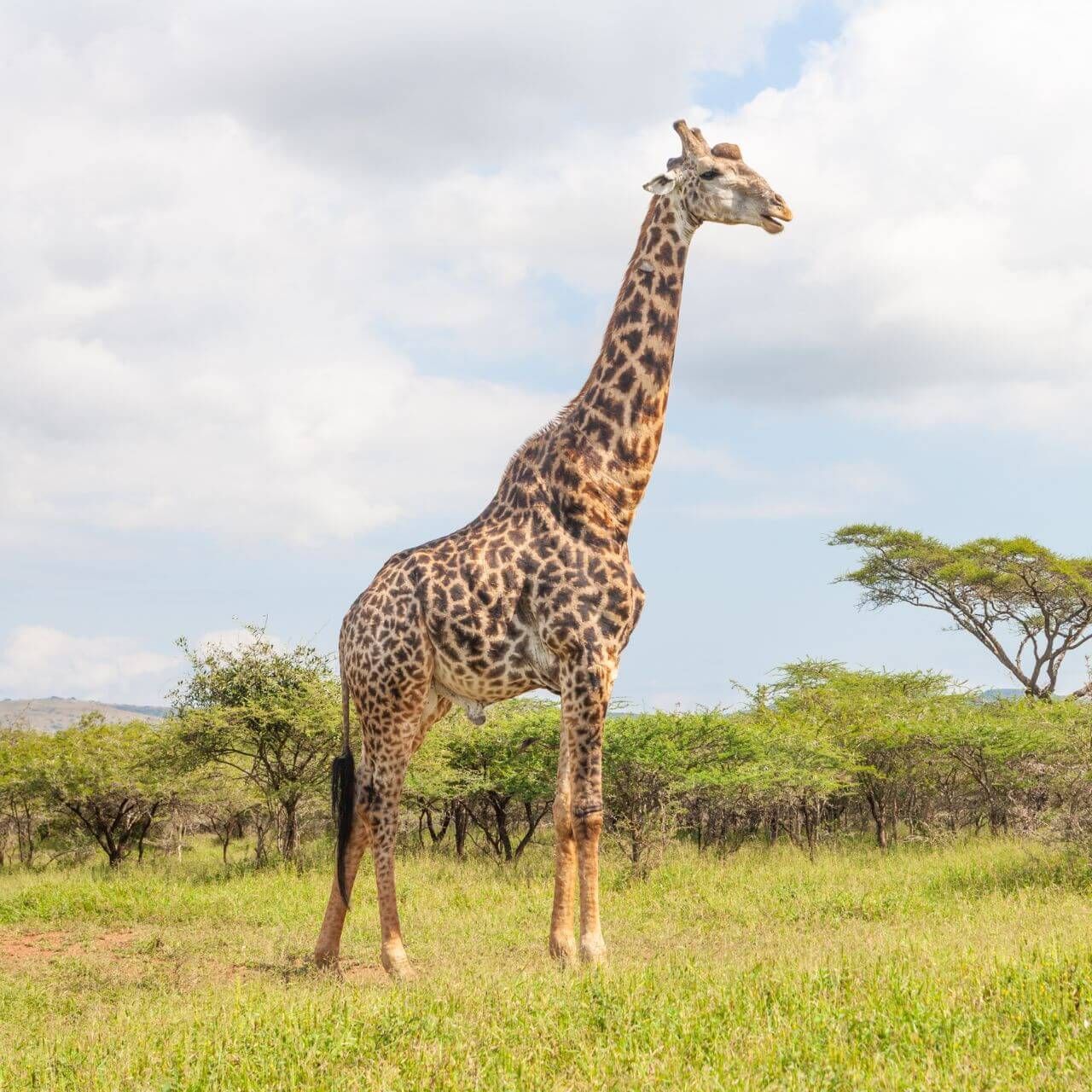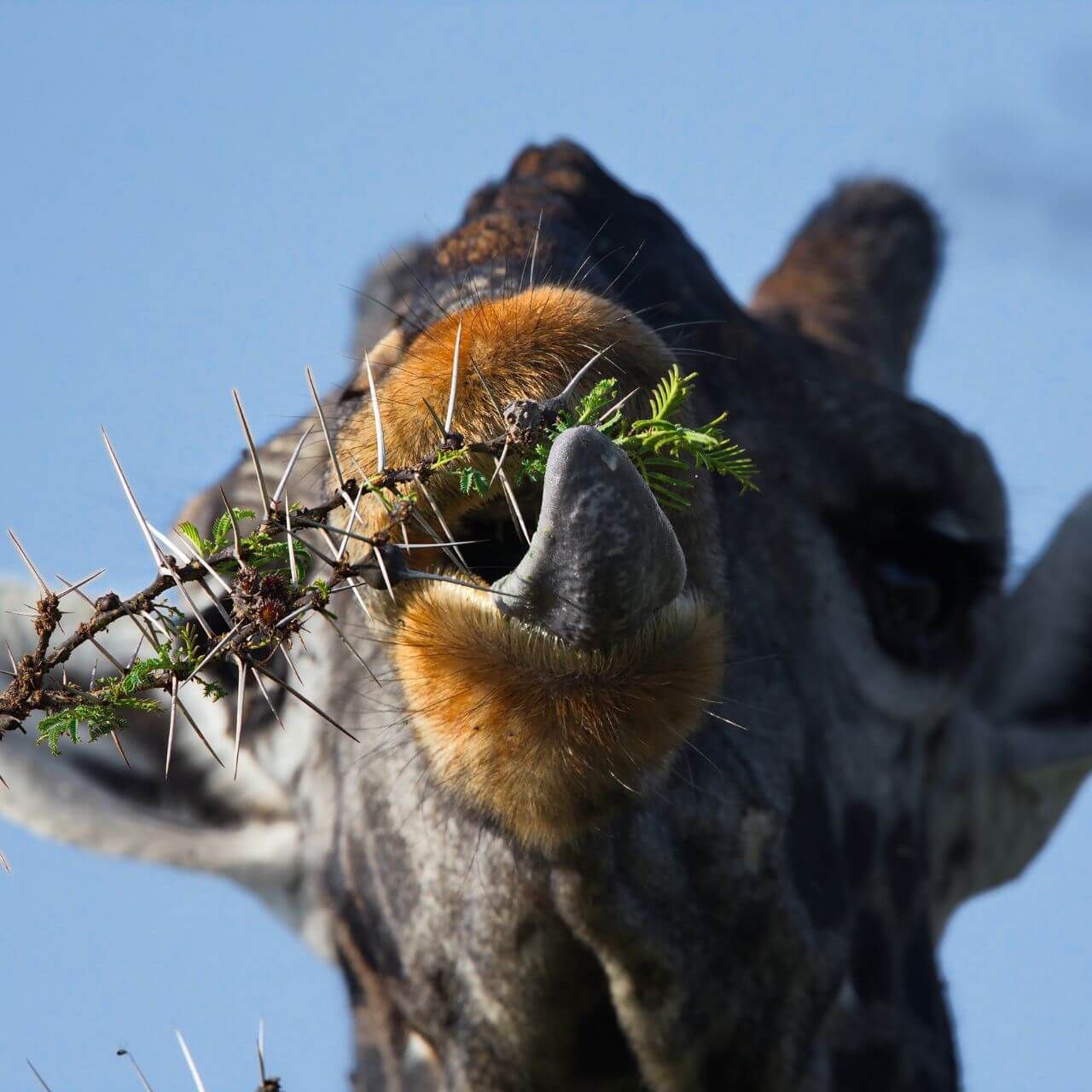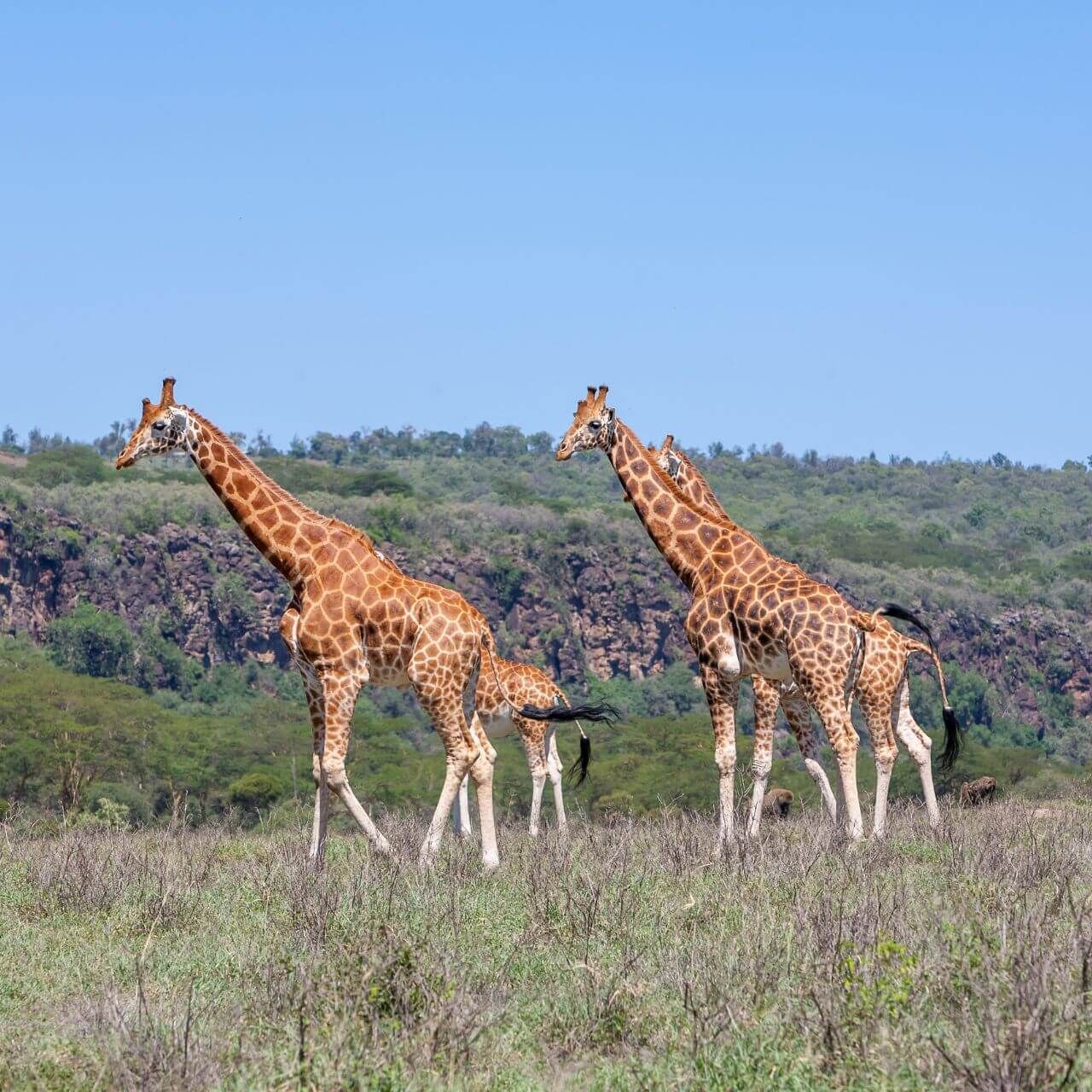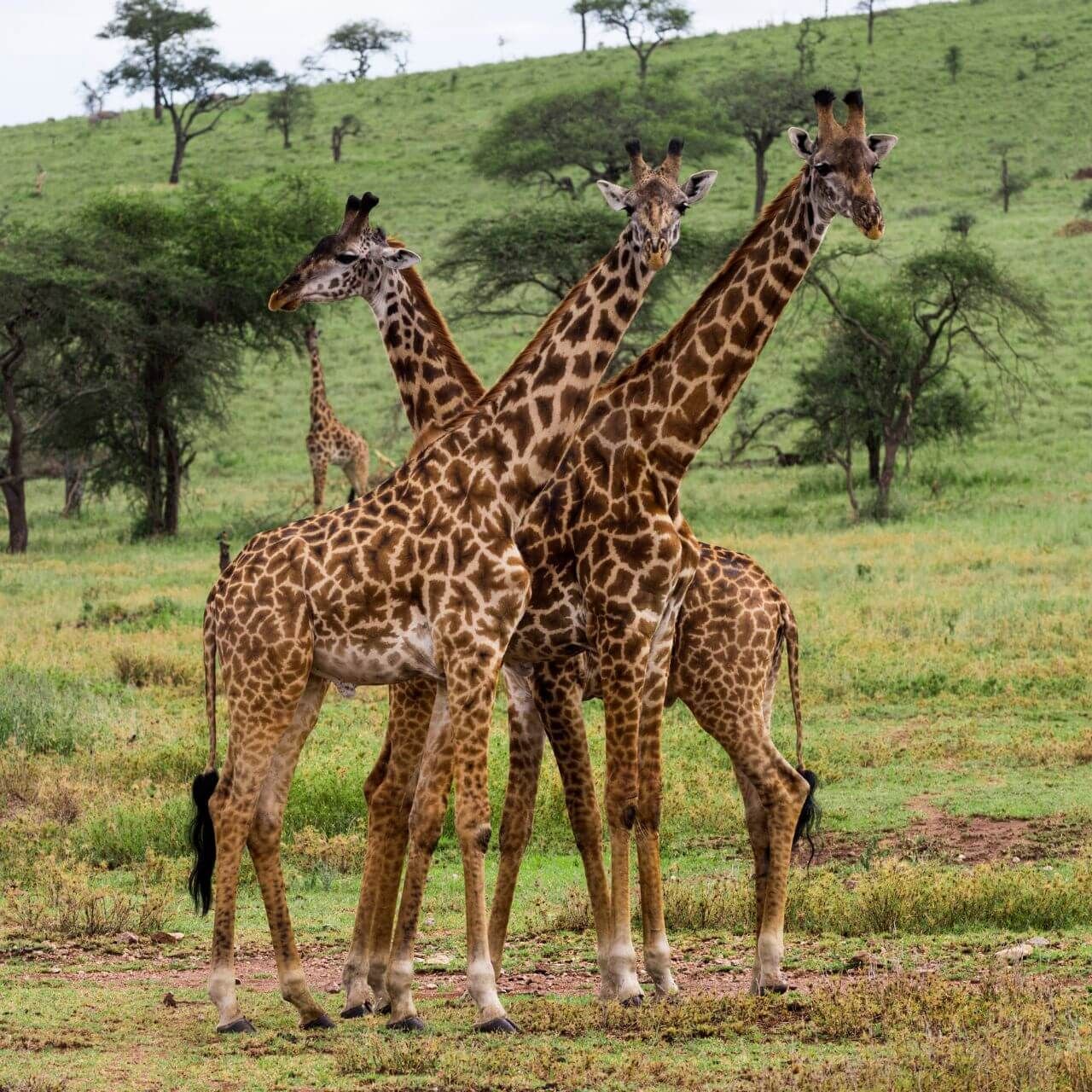Giraffes

Let's Learn About Giraffes
Word of the Week
Ossicone
Ossicones are the horn-like structures of giraffes and okapis. They are made of cartilage!
When giraffes are born, their ossicones are soft and flat. During the first several months of their lives, they harden in a process known as ossification. Males use their ossicones when fighting with other males!
Fast Facts

Where do giraffes live?
Giraffes are native to the savannas and woodlands of Africa!
Giraffes live in sub-Saharan Africa (meaning south of the Sahara desert) in open-canopy environments with acacia, bushwillow, and myrrh trees. The Angolan giraffe is found in desert ecosystems.
What do giraffes eat?
Giraffes are herbivores.
Giraffes typically spend up to 75% of the day eating. They use their long, purple tongue to eat leaves, buds, and twigs from trees, along with shrubs and fruit. They eat about 75 lbs of food per day! Giraffes are ruminants, so when they are not eating, they are ruminating.


What traits do giraffes have?
Giraffes are large mammals that...
- Have hooves.
- Have long necks.
- Have long tongues - up to 1.5 feet long!
- Have ossicones.
- Have a blotched pattern for camouflage.
How many giraffes are there?
Scientists disagree about how many species and subspecies of giraffes exist!
The Giraffe Conservation Foundation's (GCF) research has found there are 4 species of giraffes with 4 subspecies. The International Union for Conservation of Nature (IUCN) has previous found there is 1 species with 9 subspecies. The GCF estimates there are roughly 117,000 giraffes left in the wild.

Species Spotlight
Reticulated Giraffe
Giraffa reticulata -or- Giraffa camelopardalis reticulata
Reticulated giraffes, also known as Somali giraffes, are found on the savannas of eastern Africa. Compared to other giraffes, their spots are large with solid edges separated by white lines. Some scientists classify reticulated giraffes as a full species while others classify them as subspecies. Regardless, they are very closely related to other giraffes and share many traits.
Like all giraffes, reticulated giraffes are herbivores. They feed on leaves, shoots, and shrubs using their 18 inch long purple tongue. Reticulated giraffes have been observed feeding during the day and night, but are most frequently seen feeding around dawn and dusk. When not eating, giraffes spend their time resting and ruminating. Ruminants are animals that have a specialized digestive system with several parts. Giraffes eat large amounts of food that is later regurgitated, re-chewed, and then sent to finish digestion. This allows them to eat a lot of food at once and digest it later when they're resting! Reticulated giraffes graze from trees in loose herds that change frequently. The size of a herd can change based on factors like food and water availability and breeding.
Reticulated giraffes are endangered and many conservation organizations are working to protect them. By monitoring giraffes to see where they are going, what they are doing, and what threats they are facing, we can create conservation programs to save the reticulated giraffe from extinction.
BRAIN BLAST
Scientists debate how many species and subspecies of giraffes exist. If you were trying to tell 2 species apart, what traits would you look at?
Conservation Corner
Silent Extinction
As the tallest animal on land, giraffes are an iconic and well-loved species, yet giraffe conservation does not get as much attention as elephants or rhinoceroses. In the last 40 years, the number of wild giraffes in Africa has dropped by 30% due to threats like habitat loss and fragmentation, poaching, and wars among African countries. Because of the lack of awareness around threats to giraffes, scientists have dubbed this the "silent extinction."
Scientists are not sure why giraffes do not get as much attention as some other species. Perhaps because they are not poached for a body part like an elephant's tusks or a rhinoceros's horn. Perhaps because many populations live in national parks or reserves where they are protected, so tourists often see them on safaris. Regardless of the reason, one of the most important things we can do to protect giraffes is help end the silence! Tell your friends, family, and anyone that will listen that giraffe populations need our help. For those of us not in Africa, one of the greatest ways we can help is by donating to giraffe conservation groups and reducing our overall environmental impact.
Giraffes Do What?
Finding the tile that correctly finishes each sentence!
Learn More!
Glossary
Adaptation
The process by which a species becomes more fit for its environment over the course of several generations. It is a result of natural selection.
Aquatic
Living in water.
Camouflage
The ability for an organism to blend into their surroundings usually to hide from prey or predators.
Carnivore
An animal that eats other animals.
Closed Canopy
A region of forest or woodland where the tree tops touch or overlap.
Ectotherm
An animal that relies on the outside temperature to regulate their body temperature (reptiles and amphibians). Also known as cold-blooded.
Endotherm
An animal that regulates their body temperature internally (mammals and birds). Also known as warm-blooded.
Herbivore
An animal that eats mostly plants.
Invertebrate
An animal that has no bones.
Mammal
A group of endothermic (warm-blooded) vertebrates that are covered in hair, produce milk for offspring, and generally give birth to live offspring.
Omnivore
An animal that eats both plants and animals.
Open Canopy
A region of forest or woodland where the tree tops do not touch or overlap.
Predator
An animal that hunts other animals for food.
Prey
An animal that is hunted and eaten by another animal.
Ruminant
A hooved, herbivorous mammal with a specialized digestive system allowing them to eat plants, regurgitate it, and continue digesting in a different part of their stomach.
Species
A closely related group of animals with similar characteristics that are capable of reproducing (example: tigers).
Subspecies
A group of animals within a species that are genetically different from other groups in the same species (there are 6 subspecies of tigers).
Vertebrate
An animal that has a backbone.




